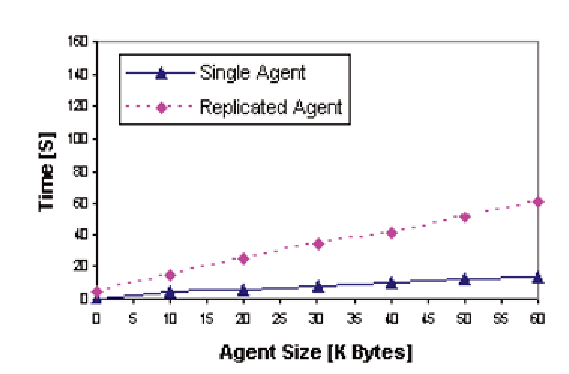Information Technology Reference
In-Depth Information
Figure 6. Costs of single and replicated agent execution increasing agent size
Figure 5 shows the number of agents on the network in a dynamic network situation. The optimal
agent population is calculated by dividing the workload on the whole network with the optimal work-
load of the agent. Simulation results show that by choosing the correct agent parameters the workload
of agents is within ten percent of the predefined visiting frequency on a stable network. In a simulated
network the population overload dynamically grows to meet the increased requirements and smoothly
returns back to normal when the congestion is over.
To measure the performance of fault tolerant mobile agent system our test consists of sequentially
sending a number of agents that increment the value of the counter at each stage of the execution. Each
agent starts at the agent source and returns to the agent destination, which allows us to measure its
round-trip time. Between two agents, the places are not restarted. Consequently, the first agent needs
considerably longer for its execution, as all classes need to be loaded into the cache of the virtual ma-
chines. Consecutive agents benefit from already cached classes and thus execute much faster. We do not
consider the first agent execution in our measurement results. For a fair comparison, we used the same
approach for the single agent case (no replication). Moreover, we assume that the Java class files are locally
available in each place. Clearly, this is a simplification, as the class files do not need to be transported
with the agent. Remote class loading adds additional costs because the classes have to be transported
with the agent and then loaded into the virtual machine. However, once the classes are loaded into the
class loader, other agents can take advantage of them and do not need to load these classes again.
The size of the agent has a considerable impact on the performance of the fault-tolerant mobile agent
execution. To measure this impact, the agent carries a Byte array of variable length used to increase
the size of the agent. As the results in Figure 6 show, the execution time of the agent increases linearly
with increasing size of the agent. Compared to the single agent, the slope of the curve for the replicated
agent is steeper.

Search WWH ::

Custom Search